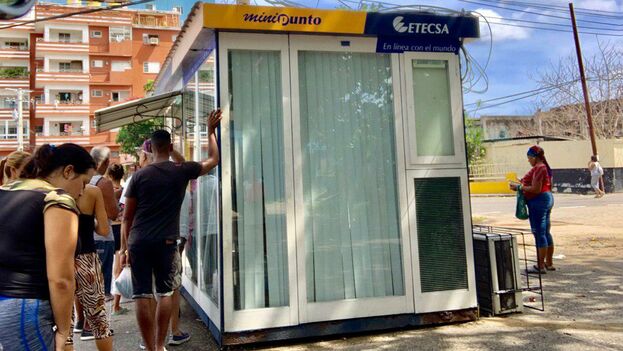
![]() 14ymedio, Yoani Sanchez, Havana, 6 December 2019 — Just one year ago, the Cuban state telecommunications monopoly, Etecsa, first enabled web browsing service from Cuban mobiles. The internet connection from cell phones came after years of pressure, complaints, and a high material, social and professional cost for a society trapped by the high rates of one hour of navigation in Wi-Fi zones and the inconvenience of having to connect to the World Wide Web from public spaces that often did not offer minimum conditions of comfort or safety.
14ymedio, Yoani Sanchez, Havana, 6 December 2019 — Just one year ago, the Cuban state telecommunications monopoly, Etecsa, first enabled web browsing service from Cuban mobiles. The internet connection from cell phones came after years of pressure, complaints, and a high material, social and professional cost for a society trapped by the high rates of one hour of navigation in Wi-Fi zones and the inconvenience of having to connect to the World Wide Web from public spaces that often did not offer minimum conditions of comfort or safety.
Twelve months after that long-awaited moment that of 6 December 2018, we can see what we have achieved but also point out everything we need to become a truly connected country.
We have spent a good part of this year complaining about the high prices, inaccessible to those who live exclusively on their salary and do not receive remittances or have the balance on their phones refilled from abroad. Etecsa’s most recent attempts to offer new packages have caused great annoyance to customers who hoped that after one year the price reduction would be substantial and significant, and who have been demanding it with the hashtag #BajenLosPricesDeInternet (Lower Internet Prices). A 4 gigabyte navigation package still costs 30 convertible pesos, the monthly salary of a professional.
Despite the high costs and problems of infrastructure and coverage mobile browsing has experienced, this service has been an important accelerator of social phenomena, a loudspeaker for a citizen with few or almost no spaces to express their annoyance or channel their complaints
Last January, thanks to internet on mobile phones, we saw the first images in more than half a century where the Cuban population booed and shouted at a ruler. A cell phone recorded and broadcast via the internet the moment in January of this year when Cuban President Miguel Díaz-Canel’s caravan passed through one of the areas most affected by the tornado in Regla (Havana). That filming made it clear that the state and partisan monopoly over the management of its public image had been shattered.
In February, the unfortunate statement by an elderly “Commander of the Revolution” about the option of Cubans eating ostrich meat unleashed teasing in social networks through popular memes, the new form of political satire expression on this island. In less than 48 hours, the public image of the military had been shattered, provoking only laughter and criticism.
Around the time of the referendum on the new Constitution on February 24 and thanks to connectivity, many Cubans within the Island showed their disagreement on Facebook and Twitter with the hashtag #YoVotoNo (I’m Voting No).
In May, through social networks, a call for a march in defense of the rights of the LGBTI community resulted in a public demonstration with dozens of participants. The political police responded violently.
Animal rights activists have also been strengthened with the mobile navigation service and, in addition to demanding a stronger animal protection law, they physically gathered in front of the notorious State Department of Zoonosis (commonly called elsewhere “the dogcatcher”) to demand the end of mass killings, which had multiplied just before the arrival in Havana of the Spanish royals. Now, these groups are doing a magnificent job of collecting, caring, sterilizing and arranging the responsible adoption of abandoned dogs and cats.
The members of the alternative SNET (Street Network) used social networks to organize protests over the new regulations of the wireless space and although, unfortunately, they were hijacked by the ruling party, their voice and their situation became well known in distant places.
The opposition has also used the new resource extensively, to denounce the arbitrary arrests, repression and imprisonment of the independent journalist Roberto Quiñones and the leader of the Patriotic Union of Cuba, José Daniel Ferrer.
During this time, live broadcasts from the Island of activists, entrepreneurs and independent reporters have multiplied. Several podcastshave also been born, including Ventana 14, (14th [floor] Window, informally known as ‘coffee and the news’; the informal market has been enhanced with connectivity and links with exile communities have also been strengthened.
But there are also shadows that have emerged along with old ones that remain. The newly established Decree-Law 389 regulates covert investigation techniques and legalizes electronic surveillance strategies that already existed but will now be carried out more publicly and quickly. Being more connected we are also more exposed to the official snooping.
The government’s own army of cybercombatants, with access to subsidized or free connections, has exacerbated cyberbullying against activists, independent journalists and critical citizens. But it has also made more evident the official nature of its positioning and use of labels.
In one year with internet on mobile phones, what we need is more than what we have achieved, but this is just beginning.
______________
COLLABORATE WITH OUR WORK: The 14ymedio team is committed to practicing serious journalism that reflects Cuba’s reality in all its depth. Thank you for joining us on this long journey. We invite you to continue supporting us by becoming a member of 14ymedio now. Together we can continue transforming journalism in Cuba.
